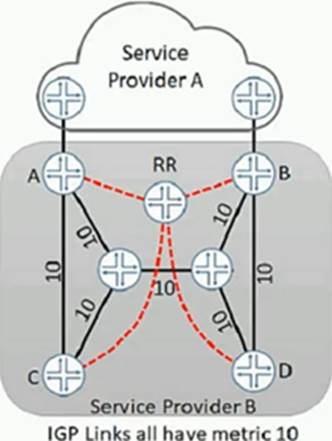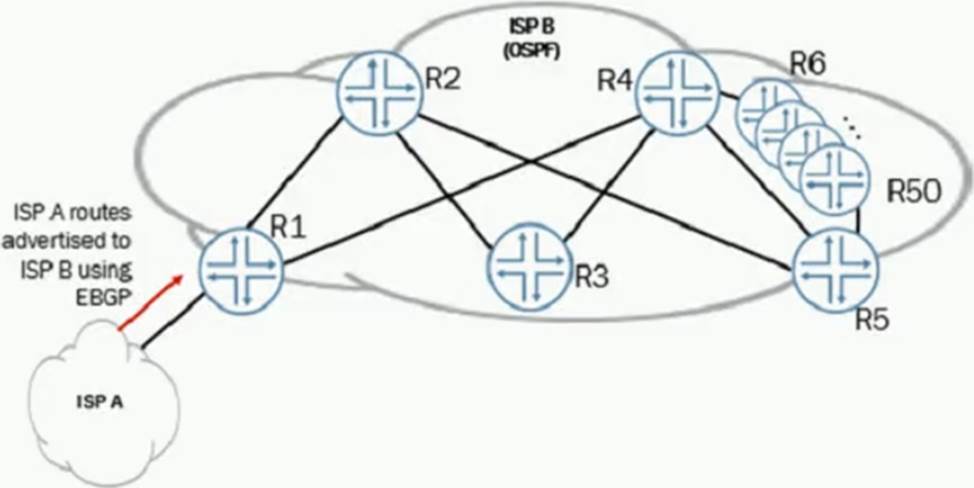Juniper JN0-1361 Service Provider Design, Specialist (JNCDS-SP) Online Training
Juniper JN0-1361 Online Training
The questions for JN0-1361 were last updated at Apr 26,2025.
- Exam Code: JN0-1361
- Exam Name: Service Provider Design, Specialist (JNCDS-SP)
- Certification Provider: Juniper
- Latest update: Apr 26,2025
Exhibit.

You work for service provider B that wants to implement a hot potato routing policy on the network so that router C uses link C-A to reach service provider A’s advertised routes and router D uses link D-B to reach Service Provider A’s advertised routes Currently traffic from router C is traversing the core to exit the network on router B.
Referring to the exhibit, what are two design actions that would satisfy the requirements? (Choose two.)
- A . Implement BGP-ORR
- B . Configure new IBGP neighbors between routers C and A and routers D and B
- C . Implement BGP-LS
- D . Configure the route reflector to send multiple copies of a route learned from different IBGP peers to its clients.
Your customer is paying for traffic prioritization and you must ensure that all traffic from their 172.27. 10.0/24 network receives top priority through your network.
Which action will satisfy this requirement?
- A . Apply a behavior aggregate classifier to the egress interface.
- B . Apply a custom rewrite rule to the ingress interface.
- C . Apply a multifield classifier to the ingress interfaces.
- D . Apply a custom scheduler map to the ingress interface.
C
Explanation:
We would need MF to match the address and set the forwarding class.
You are designing a service provider core network As part of the design, you must ensure that the MPLS network utilizes the traffic engineering database (TED) for path selection and resiliency. You have chosen OSPF as the IGP for your design.
In this scenario which statement is correct?
- A . You must enable traffic engineering in OSPF to populate the TED.
- B . OSPF cannot be used to populate the TED.
- C . You must disable traffic engineering in OSPF to use the TED.
- D . OSPF populates the TED by default.
A
Explanation:
https://www.juniper.net/documentation/en_US/junos/topics/example/ospf-traffic-engineeringenabling.html
Your company is designing a new data center in a remote location that must be connected to your local data center. You have a service provider connection between the CE devices at each site. You want to implement EVPN with VXLAN services between sites, but the service provider does not offer EVPN services.
Which two statements are true in this scenario? (Choose two )
- A . The provider’s edge devices must map your VXLAN VNIs to MPLS LSPs within the provider network at each site
- B . The customer’s edge devices within your data center can act as VXLAN Layer 2 gateways
- C . You can still implement EVPN service across the service provider as long as there is IP reachability between the sites.
- D . The service provider must provide an MPLS-based VPN connection between sites
Your WAN links are on a VPLS service from a single service provider. You must verify device configuration power and status in the event of a service outage.
Which two actions provide out-of-band management to your edge routers? (Choose two)
- A . Place management traffic on a separate VLAN on the VPLS service
- B . Connect each Ethernet management interface to a dedicated switch with traffic routed on its own subnet on the VPLS service
- C . Connect each Ethernet management interface to a dedicated switch with its own WAN connection.
- D . Connect each serial management port to a console server with a cellular Internet connection
C, D
Explanation:
https://www.wti.com/t-remote-console-and-power-management-for-juniper-switches-and-routers.aspx
Exhibit.

Which routing protocol design will accomplish these goals?
- A . Enable a full mesh of IBGP sessions between the routers in ISP B.
- B . Redistribute the BGP routes learned from ISP A into the OSPF instance running in ISP B.
- C . Configure static routes to ISP A on each router within ISP B.
- D . Configure each router in ISP B to peer with a par of route reflectors.
Your applications are migrating from a legacy data center to an EVPN over a VXLAN-based VM environment. A few critical legacy applications not support this environment and must remain on bare metal servers and the applications must be able to access the Internet.
What must be included in the VXLAN design to satisfy these requirements?
- A . VTEP tunneling
- B . VXLAN gateway
- C . SR-IOV
- D . nested VM capability
B
Explanation:
https://www.juniper.net/documentation/en_US/release-independent/solutions/topics/concept/solutionevpn-vxlan-understanding.html
Which security implementation does Juniper Networks recommend for all core routers in a service provider network?
- A . intrusion and detection prevention
- B . unified threat management
- C . application firewall
- D . stateless loopback firewall filter
What are three components of a class-of-service scheduler? (Choose three.)
- A . transmit rate
- B . forwarding class
- C . queue priority
- D . delay buffer size
- E . policing rate
A, C, D
Explanation:
Junos OS schedulers allow you to define the priority, bandwidth, delay buffer size, rate control status, and
RED drop profiles to be applied to a particular queue for packet transmission
You are designing a multi-site data center environment with data center interconnects between sites.
Which two statements are true in this scenario? (Choose two. )
- A . VPLS can be used to interconnect the multiple sites.
- B . EVPN with VXLAN can be used to interconnect the multiple sites.
- C . The data centers must be connected with a full mesh design.
- D . All data centers must be in the same Layer 2 broadcast domain and subnet.
Latest JN0-1361 Dumps Valid Version with 65 Q&As
Latest And Valid Q&A | Instant Download | Once Fail, Full Refund

